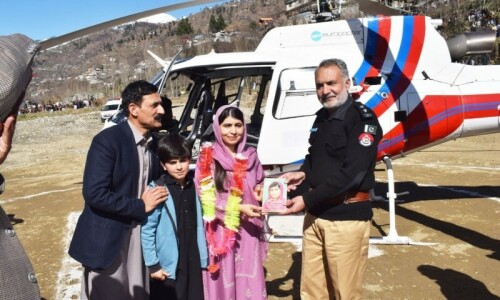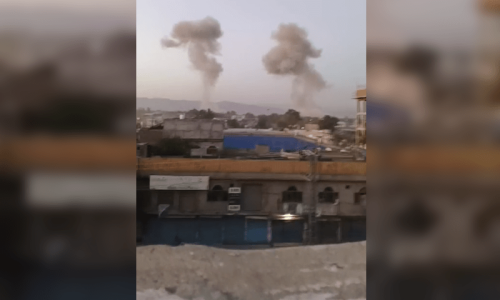PESHAWAR: Already struggling to stem the spread of dengue hemorrhagic fever in flood-hit districts of the province, the health department has recorded the rising incidence of another mosquito-borne disease, malaria, there.
In a report, the Integrated Vector Control Programme of the health department revealed that 4,819 malaria cases had been reported in the districts, where dengue is widespread, during the last two days.
It said the province had recorded 3,693 dengue cases in the year with 1,952 reported in the current month.
The programme said most of the cases of both diseases came from Mardan, Peshawar, Shangla, Khyber, Bannu, Buner, Dera Ismail Khan, Tank, Charsadda, Nowshera, Mansehra and Malakand.
Doctors in government hospitals told Dawn that the vector-borne diseases occurred after flooding and the only way to prevent it was to save one from mosquito bites.
Officials complain about lack of coordination among depts for response to crisis
They, however, said stagnant water had caused massive mosquito production in most flood-hit districts and thus, causing a high incidence of those infections.
The doctors said the presence of mosquito larva in the monsoon disaster-hit districts was a matter of concern.
The entomologists said the normal level of household index for larva presence was five but it was 6-20 in high-risk districts showing that mosquito would continue to be there to spread the diseases, especially in the areas, where flooding had disrupted electric supply.
Officials in the health department said they had been spraying chemicals in those districts as an effective way to kill mosquitoes to prevent the spread of dengue and malaria.
They, however, said they would have to scale up public awareness of ways to control mosquito-borne diseases, especially avoidance of water storage in uncovered pots and utensils.
The officials said the people should discard stored water after three days.
They said the health department’s teams were working in areas to eliminate mosquito larva through effective ‘mechanical control measures’ besides distributing bed nets among the vulnerable population.
The officials said as the cases were surging, the department had started collecting data on a daily basis for effective response to the spread of malaria and dengue.
They said dengue had so far killed five people in the province, while the number of its active cases totalled 1,003.
The officials said a total of 3,693 dengue cases had been reported in the province in the year with 1,952 in September, 1,532 in August, 163 in July and 37 in June.
The hospital records showed that a total of 495 patients were hospitalised and they included 101 in Peshawar, 33 in Nowshera and eight in Mardan and other districts. Of those cases, 271 have recovered from the infection.
The officials said the department had already circulated guidelines regarding management of vector-borne diseases to all district headquarters hospitals and medical teaching institutions in the province.
They said no hospitalisation and death from malaria had been reported in flooding.
The officials said entomological surveillance was an ongoing exercise to know about the spread of mosquito larva for an effective response.
They said there was still an active transmission of the virus in its hot spots in Mardan district.
Officials said following the surge in dengue cases, the health department had allocated beds for the patients of mosquitoes-born disease in all flood-hit districts along with thermal fogging in areas prone to mosquito production.
They said a lack of coordination among 19 departments was the main cause of concern to prevent dengue and malaria outbreaks and take effective measures against them.
Chief secretary Dr Shahzad Khan Bangash has already ordered the district coordination committees to meet regularly to discuss the control and prevention of mosquito-borne diseases and take multi-sectoral measures for larva elimination and patient care.
Published in Dawn, September 18th, 2022


















































